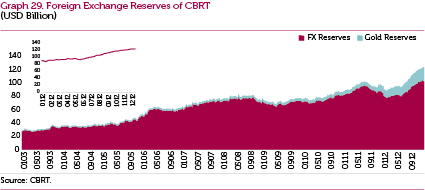2.7. Foreign Exchange Reserve and Risk Management
The CBRT holds foreign exchange reserves in support of a range of objectives which include assisting the Turkish Government in meeting its foreign exchange denominated domestic and foreign debt obligations, maintaining foreign exchange liquidity against external shocks, supporting the monetary and exchange rate policies and providing confidence to the markets. The legal basis for the CBRT's reserve management practices derives from the CBRT Law No. 1211. Additionally, guidelines and decisions made by the Board based on the authority granted by the Law constitute the other basis of the foreign exchange and gold reserve management practices.
The institutional decision making framework of reserve management has a three-tier hierarchical structure. The Board, as the top decision making authority of the Central Bank, determines the general investment criteria for reserve management by approving the Guidelines for Foreign Exchange Reserve Management that are prepared in accordance with the reserve management priorities set by the Law as security, liquidity and return and authorizes the Executive Committee and the Foreign Exchange Risk and Investment Committee (FXRIC) to make decisions regarding implementation. The decisions made by the Executive Committee and FXRIC in accordance with the Guidelines for the Foreign Exchange Reserve Management approved by the Board constitute the second-tier of the institutional decision making process. At this stage, the benchmark portfolio, which reflects the general risk tolerance and investment strategy of the Bank, is determined and approved. According to the strategic asset allocation preferences of the Bank, the benchmark portfolio is determined by the FXRIC at each year-end to be implemented in the following year and becomes effective with the approval of the Executive Committee. The last tier of the institutional decision making process is the implementation of reserve management practices within the limits specified by the Guidelines and the benchmark portfolio. Reserve management activities are carried out within an organizational structure formed in accordance with the separation of duties principle. Accordingly, reserve management activities are performed by the Foreign Exchange Transactions Division, whereas risk management relating to the reserve management operations is carried out by the Foreign Exchange Risk Management Division.
Based on the objectives and limits set by the Guidelines and the benchmark portfolio, reserve management operations are carried out through spot and forward purchases and sales of foreign exchange in international markets, other derivative instruments, time deposit transactions, purchase and sale of securities, repo and reverse repo transactions, securities lending transactions, export and import of foreign exchange banknotes and transportation of foreign exchange banknotes in the country among local branches.
Gold reserves of the CBRT, which are of international standards, are managed within the regulations and constraints stated in the Law and the guidelines set by the Board. Pursuant to these Guidelines, the CBRT may conduct outright purchase and sale transactions, gold deposit transactions and gold swap transactions. According to the new regulation effected from October 2011, Turkish commercial banks have an option to fulfill a certain portion of their reserve requirements with standard gold. Accordingly, gold holdings have risen from 195.3 tons to 362.8 tons and our gold reserves constituted 16.6 percent of our total reserves as of end-2012 (Graph 29).

The control of risks that the CBRT is exposed to during reserve management operations starts with the strategic assets allocation process; in other words, when defining the benchmark portfolio. Once the currencies and instruments to be used in reserve management and the duration target for the investments are set, to a great extent, the expected return and financial risks involved in reserve management are also determined.
Reflecting the Bank's preferences regarding strategic asset allocation, the benchmark portfolio consists of the target currency composition, duration targets and related deviation limits from these targets, the number and size of sub-portfolios to be held in major reserve currencies, overall credit risk limits and the investment universe representing eligible transaction types, countries and instruments to invest in. While determining the benchmark portfolio, the aim is to ensure that an adequate return is obtained while observing capital preservation and liquidity constraints to devote the utmost importance to the prudent management of foreign exchange reserves, hence the national wealth of the country. After the overall acceptable risk level is defined with respect to the CBRT's risk tolerance through the benchmark portfolio, the existing risks are measured, recorded and monitored regularly.
The deepening of the sovereign debt crisis in the European Union and the continuing impacts of the global financial crisis played an important role in determining the CBRT's reserve management strategies in 2012. As the financial risks remained elevated in 2012, the conservative approach continued and all necessary measures have been taken to preserve the value of reserve assets.
In brief, reserve and risk management practices have been performed in line with contemporary practices by taking into account the CBRT's own requirements and theoretical and technical progress in reserve and risk management practices together with developments in the international economy and financial markets.
.
